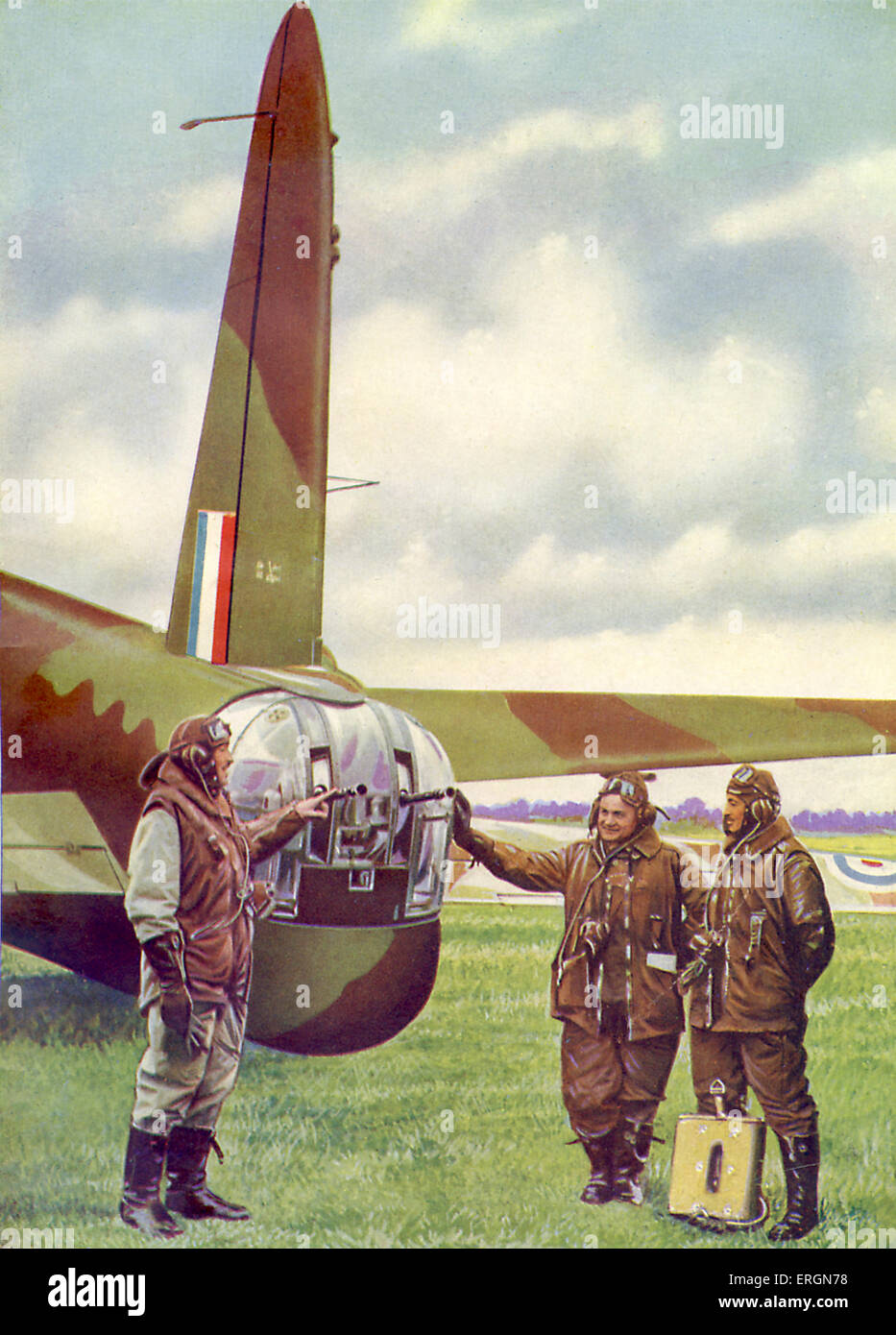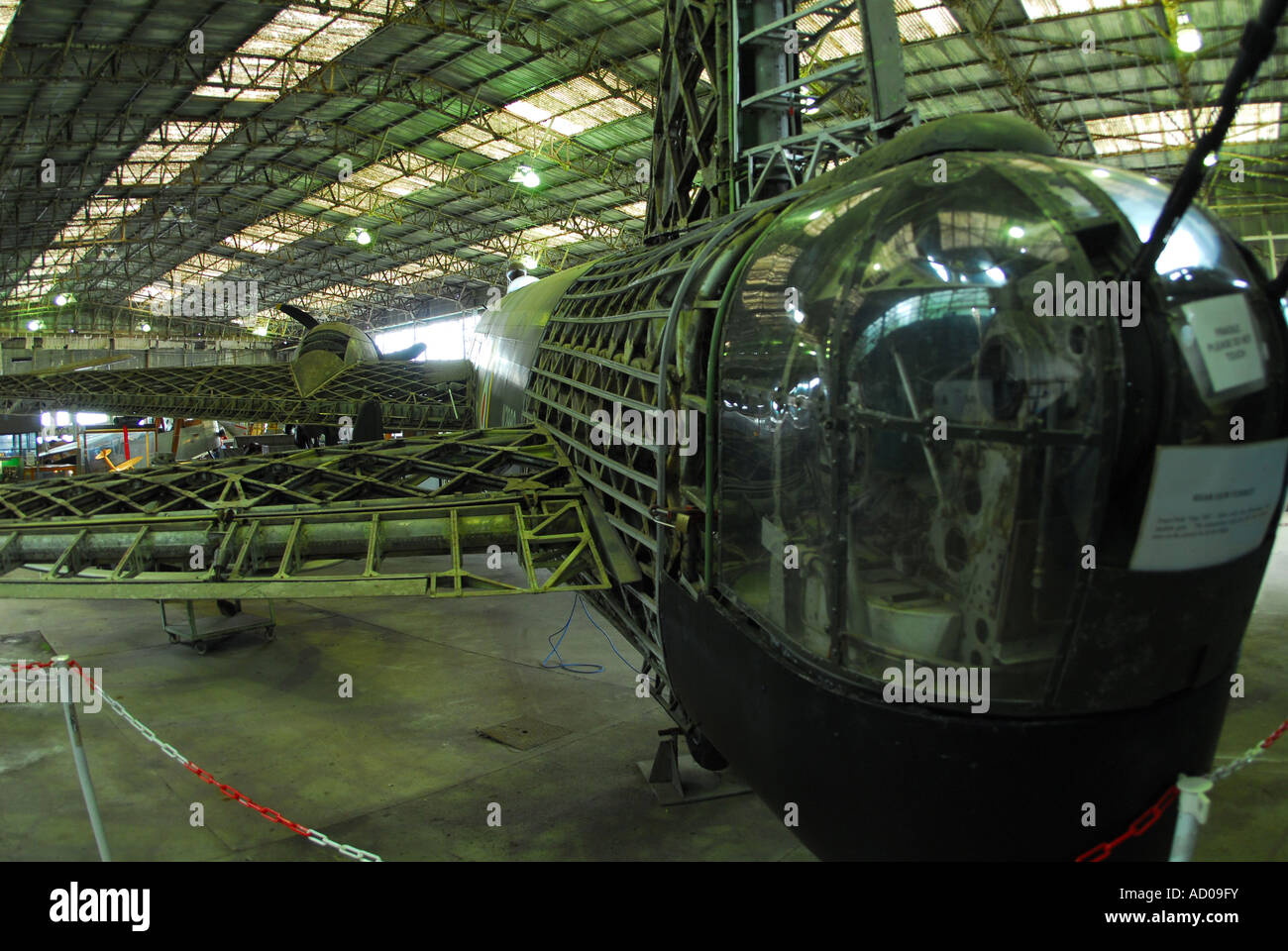Wellington bomber rear gun turret Stock Photos and Images
(6)See wellington bomber rear gun turret stock video clipsQuick filters:
Wellington bomber rear gun turret Stock Photos and Images
 WW2 - Pilots inspect the machine gun turret at the rear 'f a British Wellington bomber. Caption reads: The 'Sting' in the tail Stock Photohttps://www.alamy.com/image-license-details/?v=1https://www.alamy.com/stock-photo-ww2-pilots-inspect-the-machine-gun-turret-at-the-rear-f-a-british-83346460.html
WW2 - Pilots inspect the machine gun turret at the rear 'f a British Wellington bomber. Caption reads: The 'Sting' in the tail Stock Photohttps://www.alamy.com/image-license-details/?v=1https://www.alamy.com/stock-photo-ww2-pilots-inspect-the-machine-gun-turret-at-the-rear-f-a-british-83346460.htmlRMERGN78–WW2 - Pilots inspect the machine gun turret at the rear 'f a British Wellington bomber. Caption reads: The 'Sting' in the tail
 Rear gun turret on a part restored Wellington bomber, now at Brooklands Museum Stock Photohttps://www.alamy.com/image-license-details/?v=1https://www.alamy.com/stock-photo-rear-gun-turret-on-a-part-restored-wellington-bomber-now-at-brooklands-13262222.html
Rear gun turret on a part restored Wellington bomber, now at Brooklands Museum Stock Photohttps://www.alamy.com/image-license-details/?v=1https://www.alamy.com/stock-photo-rear-gun-turret-on-a-part-restored-wellington-bomber-now-at-brooklands-13262222.htmlRFAD09FY–Rear gun turret on a part restored Wellington bomber, now at Brooklands Museum
 The reat turret of an Armstrong Whitworth A.W.38 Whitley was a British medium bomber aircraft, one of three twin-engined, front line medium bomber types that were in service with the Royal Air Force (RAF) at the outbreak of the Second World War. Along with the Vickers Wellington and the Handley Page Hampden, the Whitley was developed during the mid-1930s. Following the outbreak of war in September 1939, the Whitley participated in the first RAF bombing raid upon German territory and remained an integral part of the British bomber offensive, until supersededby larger four-engined heavy bombers. Stock Photohttps://www.alamy.com/image-license-details/?v=1https://www.alamy.com/the-reat-turret-of-an-armstrong-whitworth-aw38-whitley-was-a-british-medium-bomber-aircraft-one-of-three-twin-engined-front-line-medium-bomber-types-that-were-in-service-with-the-royal-air-force-raf-at-the-outbreak-of-the-second-world-war-along-with-the-vickers-wellington-and-the-handley-page-hampden-the-whitley-was-developed-during-the-mid-1930s-following-the-outbreak-of-war-in-september-1939-the-whitley-participated-in-the-first-raf-bombing-raid-upon-german-territory-and-remained-an-integral-part-of-the-british-bomber-offensive-until-supersededby-larger-four-engined-heavy-bombers-image624014423.html
The reat turret of an Armstrong Whitworth A.W.38 Whitley was a British medium bomber aircraft, one of three twin-engined, front line medium bomber types that were in service with the Royal Air Force (RAF) at the outbreak of the Second World War. Along with the Vickers Wellington and the Handley Page Hampden, the Whitley was developed during the mid-1930s. Following the outbreak of war in September 1939, the Whitley participated in the first RAF bombing raid upon German territory and remained an integral part of the British bomber offensive, until supersededby larger four-engined heavy bombers. Stock Photohttps://www.alamy.com/image-license-details/?v=1https://www.alamy.com/the-reat-turret-of-an-armstrong-whitworth-aw38-whitley-was-a-british-medium-bomber-aircraft-one-of-three-twin-engined-front-line-medium-bomber-types-that-were-in-service-with-the-royal-air-force-raf-at-the-outbreak-of-the-second-world-war-along-with-the-vickers-wellington-and-the-handley-page-hampden-the-whitley-was-developed-during-the-mid-1930s-following-the-outbreak-of-war-in-september-1939-the-whitley-participated-in-the-first-raf-bombing-raid-upon-german-territory-and-remained-an-integral-part-of-the-british-bomber-offensive-until-supersededby-larger-four-engined-heavy-bombers-image624014423.htmlRM2Y768NB–The reat turret of an Armstrong Whitworth A.W.38 Whitley was a British medium bomber aircraft, one of three twin-engined, front line medium bomber types that were in service with the Royal Air Force (RAF) at the outbreak of the Second World War. Along with the Vickers Wellington and the Handley Page Hampden, the Whitley was developed during the mid-1930s. Following the outbreak of war in September 1939, the Whitley participated in the first RAF bombing raid upon German territory and remained an integral part of the British bomber offensive, until supersededby larger four-engined heavy bombers.
 THE ROYAL AIR FORCE PILOT TRAINING IN THE SECOND WORLD WAR - Crew member of No. 305 Polish Bomber Squadron explaining rear-gun turret of his Wellington IV (Z1248) to some trainee pilots of No. 7 Elementary Flying Training School. RAF Desford, 24-26 November 1942 Royal Air Force, Polish Air Force, Polish Air Force, 305 'Land of Greater Poland' Bomber Squadron, Royal Air Force, Service Flying Training School, 7, Peterborough Stock Photohttps://www.alamy.com/image-license-details/?v=1https://www.alamy.com/the-royal-air-force-pilot-training-in-the-second-world-war-crew-member-of-no-305-polish-bomber-squadron-explaining-rear-gun-turret-of-his-wellington-iv-z1248-to-some-trainee-pilots-of-no-7-elementary-flying-training-school-raf-desford-24-26-november-1942-royal-air-force-polish-air-force-polish-air-force-305-land-of-greater-poland-bomber-squadron-royal-air-force-service-flying-training-school-7-peterborough-image603082889.html
THE ROYAL AIR FORCE PILOT TRAINING IN THE SECOND WORLD WAR - Crew member of No. 305 Polish Bomber Squadron explaining rear-gun turret of his Wellington IV (Z1248) to some trainee pilots of No. 7 Elementary Flying Training School. RAF Desford, 24-26 November 1942 Royal Air Force, Polish Air Force, Polish Air Force, 305 'Land of Greater Poland' Bomber Squadron, Royal Air Force, Service Flying Training School, 7, Peterborough Stock Photohttps://www.alamy.com/image-license-details/?v=1https://www.alamy.com/the-royal-air-force-pilot-training-in-the-second-world-war-crew-member-of-no-305-polish-bomber-squadron-explaining-rear-gun-turret-of-his-wellington-iv-z1248-to-some-trainee-pilots-of-no-7-elementary-flying-training-school-raf-desford-24-26-november-1942-royal-air-force-polish-air-force-polish-air-force-305-land-of-greater-poland-bomber-squadron-royal-air-force-service-flying-training-school-7-peterborough-image603082889.htmlRM2X14PAH–THE ROYAL AIR FORCE PILOT TRAINING IN THE SECOND WORLD WAR - Crew member of No. 305 Polish Bomber Squadron explaining rear-gun turret of his Wellington IV (Z1248) to some trainee pilots of No. 7 Elementary Flying Training School. RAF Desford, 24-26 November 1942 Royal Air Force, Polish Air Force, Polish Air Force, 305 'Land of Greater Poland' Bomber Squadron, Royal Air Force, Service Flying Training School, 7, Peterborough
 Royal Air Force Bomber Command, 1942-1945. Damage to Vickers Wellington Mark X, HE239 'NA-Y', of No. 428 Squadron RCAF based at Dalton, Yorkshire, resulting from a direct hit from anti-aircraft gun fire while approaching to bomb Duisburg, Germany on the night of 8/9 April 1943. Despite the loss of the rear turret and its gunner, as well as other extensive damage, the pilot, Sergeant L F Williamson, continued to bomb the target, following which it was found that the bomb doors could not be closed because of a complete loss of hydraulic power. Williamson nevertheless brought HE239 and the remain Stock Photohttps://www.alamy.com/image-license-details/?v=1https://www.alamy.com/royal-air-force-bomber-command-1942-1945-damage-to-vickers-wellington-mark-x-he239-na-y-of-no-428-squadron-rcaf-based-at-dalton-yorkshire-resulting-from-a-direct-hit-from-anti-aircraft-gun-fire-while-approaching-to-bomb-duisburg-germany-on-the-night-of-89-april-1943-despite-the-loss-of-the-rear-turret-and-its-gunner-as-well-as-other-extensive-damage-the-pilot-sergeant-l-f-williamson-continued-to-bomb-the-target-following-which-it-was-found-that-the-bomb-doors-could-not-be-closed-because-of-a-complete-loss-of-hydraulic-power-williamson-nevertheless-brought-he239-and-the-remain-image568984684.html
Royal Air Force Bomber Command, 1942-1945. Damage to Vickers Wellington Mark X, HE239 'NA-Y', of No. 428 Squadron RCAF based at Dalton, Yorkshire, resulting from a direct hit from anti-aircraft gun fire while approaching to bomb Duisburg, Germany on the night of 8/9 April 1943. Despite the loss of the rear turret and its gunner, as well as other extensive damage, the pilot, Sergeant L F Williamson, continued to bomb the target, following which it was found that the bomb doors could not be closed because of a complete loss of hydraulic power. Williamson nevertheless brought HE239 and the remain Stock Photohttps://www.alamy.com/image-license-details/?v=1https://www.alamy.com/royal-air-force-bomber-command-1942-1945-damage-to-vickers-wellington-mark-x-he239-na-y-of-no-428-squadron-rcaf-based-at-dalton-yorkshire-resulting-from-a-direct-hit-from-anti-aircraft-gun-fire-while-approaching-to-bomb-duisburg-germany-on-the-night-of-89-april-1943-despite-the-loss-of-the-rear-turret-and-its-gunner-as-well-as-other-extensive-damage-the-pilot-sergeant-l-f-williamson-continued-to-bomb-the-target-following-which-it-was-found-that-the-bomb-doors-could-not-be-closed-because-of-a-complete-loss-of-hydraulic-power-williamson-nevertheless-brought-he239-and-the-remain-image568984684.htmlRM2T1KDNG–Royal Air Force Bomber Command, 1942-1945. Damage to Vickers Wellington Mark X, HE239 'NA-Y', of No. 428 Squadron RCAF based at Dalton, Yorkshire, resulting from a direct hit from anti-aircraft gun fire while approaching to bomb Duisburg, Germany on the night of 8/9 April 1943. Despite the loss of the rear turret and its gunner, as well as other extensive damage, the pilot, Sergeant L F Williamson, continued to bomb the target, following which it was found that the bomb doors could not be closed because of a complete loss of hydraulic power. Williamson nevertheless brought HE239 and the remain
 ROYAL AIR FORCE BOMBER COMMAND, 1942-1945. - Damage to Vickers Wellington Mark X, HE239 'NA-Y', of No. 428 Squadron RCAF based at Dalton, Yorkshire, resulting from a direct hit from anti-aircraft gun fire while approaching to bomb Duisburg, Germany on the night of 8/9 April 1943. Despite the loss of the rear turret and its gunner, as well as other extensive damage, the pilot, Sergeant L F Williamson, continued to bomb the target, following which it was found that the bomb doors could not be closed because of a complete loss of hydraulic power. Williamson nevertheless brought HE239 and the rema Stock Photohttps://www.alamy.com/image-license-details/?v=1https://www.alamy.com/royal-air-force-bomber-command-1942-1945-damage-to-vickers-wellington-mark-x-he239-na-y-of-no-428-squadron-rcaf-based-at-dalton-yorkshire-resulting-from-a-direct-hit-from-anti-aircraft-gun-fire-while-approaching-to-bomb-duisburg-germany-on-the-night-of-89-april-1943-despite-the-loss-of-the-rear-turret-and-its-gunner-as-well-as-other-extensive-damage-the-pilot-sergeant-l-f-williamson-continued-to-bomb-the-target-following-which-it-was-found-that-the-bomb-doors-could-not-be-closed-because-of-a-complete-loss-of-hydraulic-power-williamson-nevertheless-brought-he239-and-the-rema-image602850117.html
ROYAL AIR FORCE BOMBER COMMAND, 1942-1945. - Damage to Vickers Wellington Mark X, HE239 'NA-Y', of No. 428 Squadron RCAF based at Dalton, Yorkshire, resulting from a direct hit from anti-aircraft gun fire while approaching to bomb Duisburg, Germany on the night of 8/9 April 1943. Despite the loss of the rear turret and its gunner, as well as other extensive damage, the pilot, Sergeant L F Williamson, continued to bomb the target, following which it was found that the bomb doors could not be closed because of a complete loss of hydraulic power. Williamson nevertheless brought HE239 and the rema Stock Photohttps://www.alamy.com/image-license-details/?v=1https://www.alamy.com/royal-air-force-bomber-command-1942-1945-damage-to-vickers-wellington-mark-x-he239-na-y-of-no-428-squadron-rcaf-based-at-dalton-yorkshire-resulting-from-a-direct-hit-from-anti-aircraft-gun-fire-while-approaching-to-bomb-duisburg-germany-on-the-night-of-89-april-1943-despite-the-loss-of-the-rear-turret-and-its-gunner-as-well-as-other-extensive-damage-the-pilot-sergeant-l-f-williamson-continued-to-bomb-the-target-following-which-it-was-found-that-the-bomb-doors-could-not-be-closed-because-of-a-complete-loss-of-hydraulic-power-williamson-nevertheless-brought-he239-and-the-rema-image602850117.htmlRM2X0P5D9–ROYAL AIR FORCE BOMBER COMMAND, 1942-1945. - Damage to Vickers Wellington Mark X, HE239 'NA-Y', of No. 428 Squadron RCAF based at Dalton, Yorkshire, resulting from a direct hit from anti-aircraft gun fire while approaching to bomb Duisburg, Germany on the night of 8/9 April 1943. Despite the loss of the rear turret and its gunner, as well as other extensive damage, the pilot, Sergeant L F Williamson, continued to bomb the target, following which it was found that the bomb doors could not be closed because of a complete loss of hydraulic power. Williamson nevertheless brought HE239 and the rema